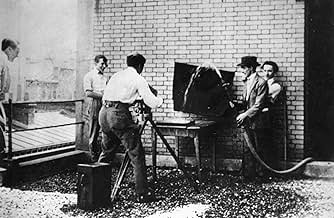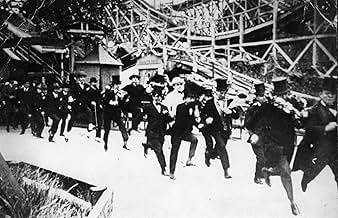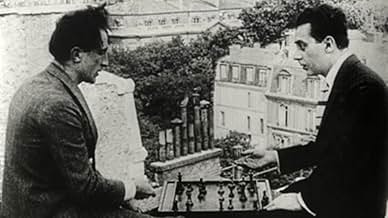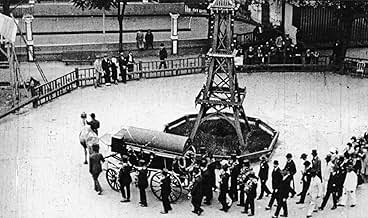Entr'acte
- 1924
- 22 Min.
IMDb-BEWERTUNG
7,3/10
4379
IHRE BEWERTUNG
Füge eine Handlung in deiner Sprache hinzuAn absolute dada movie. Somebody gets killed, his coffin gets out of control and after a chase it stops. The person gets out of it and let everybody who followed the coffin dissapear.An absolute dada movie. Somebody gets killed, his coffin gets out of control and after a chase it stops. The person gets out of it and let everybody who followed the coffin dissapear.An absolute dada movie. Somebody gets killed, his coffin gets out of control and after a chase it stops. The person gets out of it and let everybody who followed the coffin dissapear.
Inge Frïss
- La ballerine
- (as Mlle Frïss)
Man Ray
- Un joueur d'échecs
- (as Man-Ray)
Marcel Achard
- Un homme qui suit le corbillard
- (Nicht genannt)
Georges Auric
- Un homme qui suit le corbillard
- (Nicht genannt)
Georges Charensol
- Un homme qui suit le corbillard
- (Nicht genannt)
Georges Lacombe
- Un homme qui suit le corbillard
- (Nicht genannt)
Roger Le Bon
- Un homme qui suit le corbillard
- (Nicht genannt)
Jean Mamy
- Un homme qui suit le corbillard
- (Nicht genannt)
Rolf de Maré
- Un homme qui suit le corbillard
- (Nicht genannt)
Erik Satie
- Un homme qui charge le canon
- (Nicht genannt)
Pierre Scize
- Un homme qui suit le corbillard
- (Nicht genannt)
Louis Touchages
- Un homme qui suit le corbillard
- (Nicht genannt)
Empfohlene Bewertungen
I watched Entr'acte (1924) during my first encounter with underground films, specifically in its avant-garde subgenre from the 1920s. This film, along with Buñuel-Dali's Un Chien Andalou (1927), immediately captivated me. Concurrently, I was studying Maya Dere's films, which inspired me to start creating my own underground/amateur/experimental short films between 2012 and 2015.
In Sheldon Renan's book on Underground Film, Entr'acte is considered one of the most impressive avant-garde films ever made. Renan labels it a "predecessor" of the underground film movement, which was then categorized as avant-garde. Entr'acte truly deserves this recognition because, considering the etymology of the term, it was undoubtedly a film ahead of its time. It stood apart from the mainstream Hollywood productions that dominated the era. René Clair, Man Ray, and Marcel Duchamp were acutely aware of the offerings to the strict bourgeois elite in Paris during a ballet concert. In the interlude between acts, they courageously introduced surrealist and dadaist ideas in film, challenging the norms of the time. This act demonstrated that Europe, particularly France, could also pioneer something revolutionary in this art form, breaking away from the conventions of Hollywood and mainstream cinema.
I would like to point out a particular scene in Entr'acte that could be interpreted as a metaphor for this subtle opposition to mainstream Hollywood and commercial films. In this scene, a man in Entr'acte fires a bullet from a shotgun directly at a balloon, which releases a dove. This imagery serves as a metaphor for liberation from the rigidity of standards not only within hegemonic Hollywood but also in cinema at large. It symbolizes the beginning of a new era, marked by the freedom to experiment with various forms and aesthetics. This period reached its peak in the 1960s, embracing a wide range of films that, while diverse in aesthetics, shared the spirit of freedom to explore cinematic possibilities. These filmmakers and artists, along with their successors, played a crucial role in advancing film techniques, many of which were developed specifically for their unconventional creations.
In Sheldon Renan's book on Underground Film, Entr'acte is considered one of the most impressive avant-garde films ever made. Renan labels it a "predecessor" of the underground film movement, which was then categorized as avant-garde. Entr'acte truly deserves this recognition because, considering the etymology of the term, it was undoubtedly a film ahead of its time. It stood apart from the mainstream Hollywood productions that dominated the era. René Clair, Man Ray, and Marcel Duchamp were acutely aware of the offerings to the strict bourgeois elite in Paris during a ballet concert. In the interlude between acts, they courageously introduced surrealist and dadaist ideas in film, challenging the norms of the time. This act demonstrated that Europe, particularly France, could also pioneer something revolutionary in this art form, breaking away from the conventions of Hollywood and mainstream cinema.
I would like to point out a particular scene in Entr'acte that could be interpreted as a metaphor for this subtle opposition to mainstream Hollywood and commercial films. In this scene, a man in Entr'acte fires a bullet from a shotgun directly at a balloon, which releases a dove. This imagery serves as a metaphor for liberation from the rigidity of standards not only within hegemonic Hollywood but also in cinema at large. It symbolizes the beginning of a new era, marked by the freedom to experiment with various forms and aesthetics. This period reached its peak in the 1960s, embracing a wide range of films that, while diverse in aesthetics, shared the spirit of freedom to explore cinematic possibilities. These filmmakers and artists, along with their successors, played a crucial role in advancing film techniques, many of which were developed specifically for their unconventional creations.
While not nearly as well-recognized or well-remembered as the Luis Bunuel classic "Un Chien Andalous" (1929), "Entr'acte" is a fairly known work in Dadaism of the 1920's, possibly one of the earliest shorts to focus on the avant-garde rather then attempt a story. Intended as an "entr'acte" (so the title suggests) for the French ballet "Relâche", the film appears to be a mere experimentation with effects while crafting a rather odd plot in the process--and more of a plot than most of the surrealistic works contain. Quite sadly, it was Rene Clair's only attempt at such a form of filmmaking, and had he gone on to lead the movement further he may have come up with even crazier material.
The image most of us remember when we think of this movie (if we do think of this movie, which many may not) is the shot of the bearded ballet dancer, reportedly played by Clair himself. This is a rather odd sight to see in a movie, and one you wouldn't normally see--likewise the rest of the short. Experimenting with slow motion, reverse motion, upside-down and side-to-side camera angles, and a number of dizzying double-exposures, the film's narrative is a rather odd one of a man shooting at a large egg only to be murdered by another man afterwards. This sets up the strange premise and the rest of the film is largely a crazy chase as the mourners of the man pursue his coffin after the hearse gets out of control. The ending, not to be spoiled, (although already spoiled by IMDb's summary) is a weird one to boot.
As others have commented, this short is hardly dark and is more of a comedy to watch than the later surrealist efforts. Plus, the opening sequences (such as the balloon dolls) hardly have anything to do with the rest of the short and the ballet dancer is entirely unconnected to the rest of it. It feels as though they were taking the first few minutes to experiment with other visuals before progressing with the true 'narrative', if one could call it that. Not to be considered a surrealist film, however; the wonderfully dizzying use of exposures is pure Dada all the way. A very creditable early effort in its exceedingly memorable imagery, and every bit as deserving to be a landmark classic as "Un Chien Andalou".
The image most of us remember when we think of this movie (if we do think of this movie, which many may not) is the shot of the bearded ballet dancer, reportedly played by Clair himself. This is a rather odd sight to see in a movie, and one you wouldn't normally see--likewise the rest of the short. Experimenting with slow motion, reverse motion, upside-down and side-to-side camera angles, and a number of dizzying double-exposures, the film's narrative is a rather odd one of a man shooting at a large egg only to be murdered by another man afterwards. This sets up the strange premise and the rest of the film is largely a crazy chase as the mourners of the man pursue his coffin after the hearse gets out of control. The ending, not to be spoiled, (although already spoiled by IMDb's summary) is a weird one to boot.
As others have commented, this short is hardly dark and is more of a comedy to watch than the later surrealist efforts. Plus, the opening sequences (such as the balloon dolls) hardly have anything to do with the rest of the short and the ballet dancer is entirely unconnected to the rest of it. It feels as though they were taking the first few minutes to experiment with other visuals before progressing with the true 'narrative', if one could call it that. Not to be considered a surrealist film, however; the wonderfully dizzying use of exposures is pure Dada all the way. A very creditable early effort in its exceedingly memorable imagery, and every bit as deserving to be a landmark classic as "Un Chien Andalou".
10m67165
This is it, for me! Absolute pure cinematic fun! This movie is not trying to tell you a story, although there is a plot about a funeral that ends up transforming into some unexpected events. I just had to laugh, and also marvel at some images that are simply beautiful, like some sort of silent visual music.
What the director does is basically a collage of absurd images and some camera tricks. These involve some artists of the time. I must say I am quite surprised by its freshness even today. Now I know where musical video clips come from! The first time I saw it, I was going to see some old silent movies, and this one was shown first, and I had no idea what it was all about. In a way, I still don't, and that's even better! Stop making sense for a while and start the fun!
What the director does is basically a collage of absurd images and some camera tricks. These involve some artists of the time. I must say I am quite surprised by its freshness even today. Now I know where musical video clips come from! The first time I saw it, I was going to see some old silent movies, and this one was shown first, and I had no idea what it was all about. In a way, I still don't, and that's even better! Stop making sense for a while and start the fun!
Originally played as an intermission with no sound, this film is now a must for any fan/historian of fine art. Featuring cameos by Man Ray, Marcel Duchamp, and other notables, Clair and Picabia's dada collage of different narratives, experimental use of the camera, and surrealist and absurdist images is the best example of experimental or dadaist films from the period. As unusual as it is to watch a film with no sound, the images created by the artists provide an extremely unique experience for the viewer. Fun for anyone, and especially interesting for those acquainted with the artists or the art movements themselves.
Entr'acte is a light-hearted example of Dada cinema of the 1920's. The tone is consistently playful and silly and you can just tell that the film-makers are having a laugh throughout. I'm certainly not too convinced that there is any particular message here. The emphasis of the film is using the cinematic medium to showcase inventive and surreal imagery in an amusing way. The narrative, such as it is, has us follow a funeral march. Although seeing as this is a Dada film, it's not exactly an ordinary march. For one thing it's led by a camel, and for another, the people in the procession bound around in slow motion for no discernible reason other than it looks funny.
The film itself was conceived as something to be shown in an intermission between other films. It clearly was never meant to be taken too seriously, and it's quite obvious that it was made in a way that allowed some of the leading proponents of the Dada/Surrealist movement to have fun and go for laughs. Surrealism was often an art-form with a sense of humour in any case, as anyone familiar with Salvador Dali's work could attest. Like most art films from the 20's Entr'acte has aged remarkably well and like others displays a sensibility that would be replicated many decades later in avant-garde cinema of the 60's and pop videos of the 80's and beyond. All-in-all a fun film to see.
The film itself was conceived as something to be shown in an intermission between other films. It clearly was never meant to be taken too seriously, and it's quite obvious that it was made in a way that allowed some of the leading proponents of the Dada/Surrealist movement to have fun and go for laughs. Surrealism was often an art-form with a sense of humour in any case, as anyone familiar with Salvador Dali's work could attest. Like most art films from the 20's Entr'acte has aged remarkably well and like others displays a sensibility that would be replicated many decades later in avant-garde cinema of the 60's and pop videos of the 80's and beyond. All-in-all a fun film to see.
Wusstest du schon
- WissenswertesThe ballet "Relâche" ("Theatre Closed") premiered at the Théâtre des Champs Elyseés in Paris on December 4, 1924. Based on a book and with settings by Francis Picabia, it was a ballet in two acts commissioned and staged by the Ballets Suédois of Rolf de Maré, with choreography by Jean Börlin. As the title "Entr'acte" implies, this film was shown between the two acts, with music by Erik Satie.
- PatzerObvious stand-in for the close-up of Rolf de Maré getting kicked in head, which sends him (via reverse motion) flying back into the end title. The "kick" itself is clearly achieved through reverse motion.
- Alternative VersionenThere is an Italian edition of this film on DVD, distributed by DNA Srl (2 Films on a single DVD). The film has been re-edited with the contribution of film historian Riccardo Cusin. This version is also available for streaming on some platforms.
- VerbindungenEdited into Avant-garde Cinema (1960)
Top-Auswahl
Melde dich zum Bewerten an und greife auf die Watchlist für personalisierte Empfehlungen zu.
Details
- Laufzeit
- 22 Min.
- Farbe
- Sound-Mix
- Seitenverhältnis
- 1.33 : 1
Zu dieser Seite beitragen
Bearbeitung vorschlagen oder fehlenden Inhalt hinzufügen






















